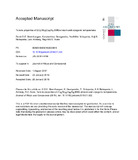JavaScript is disabled for your browser. Some features of this site may not work without it.
| dc.contributor.author | Brennhaugen, David D. E. | |
| dc.contributor.author | Georgarakis, Konstantinos | |
| dc.contributor.author | Yokoyama, Yoshihiko | |
| dc.contributor.author | Nakayama, Koji S. | |
| dc.contributor.author | Arnberg, Lars | |
| dc.contributor.author | Aune, Ragnhild E. | |
| dc.date.accessioned | 2018-02-21T15:22:33Z | |
| dc.date.available | 2018-02-21T15:22:33Z | |
| dc.date.issued | 2018-01-31 | |
| dc.identifier.citation | David D. E. Brennhaugen, Konstantinos Georgarakis, Yoshihiko Yokoyama, et al., Tensile properties of Zr70Ni16Cu6Al8 BMG at room and cryogenic temperatures. Journal of Alloys and Compounds, Volume 742, 25 April 2018, Pages 952-957 | en_UK |
| dc.identifier.issn | 0925-8388 | |
| dc.identifier.uri | https://doi.org/10.1016/j.jallcom.2018.01.322 | |
| dc.identifier.uri | https://dspace.lib.cranfield.ac.uk/handle/1826/13025 | |
| dc.description.abstract | The mechanical behaviour in tension of a hypoeutectic Zr70Ni16Cu6Al8 Bulk Metallic Glass (BMG) was studied at room (295 K) and cryogenic temperatures (150 K and 77 K) using various strain rates between 10−4 and 10−1 s−1. The yield strength was found to increase at lower temperatures with average values increasing by 16%, from 1503 MPa at 295 K to 1746 MPa at 77 K. The Zr-based BMG was found to exhibit tensile plastic elongation of about 0.4% before fracture at room temperature and high strain rates (10−1 s−1). Even higher tensile plasticity was recorded at low temperatures; plastic deformation was found highest at the intermediate temperature (150 K) reaching remarkable plastic strains in the order of 3.9%, while values up to 1.5% were recorded at 77 K. The lateral surface of the tensile specimens was observed in-situ during deformation using a high frame rate camera offering interesting insights with regard to the deformation mechanisms. Room temperature plasticity occurred through the formation and interaction of several nucleated shear bands before critical failure, while at intermediate and liquid nitrogen temperatures, most of the plastic deformation was accommodated through stable flow within a single shear band. | en_UK |
| dc.language.iso | en | en_UK |
| dc.publisher | Elsevier | en_UK |
| dc.rights | Attribution-NonCommercial-NoDerivatives 4.0 International | * |
| dc.rights.uri | http://creativecommons.org/licenses/by-nc-nd/4.0/ | * |
| dc.subject | Amorphous materials | en_UK |
| dc.subject | Metallic glasses | en_UK |
| dc.subject | Mechanical properties | en_UK |
| dc.title | Tensile properties of Zr70Ni16Cu6Al8 BMG at room and cryogenic temperatures | en_UK |
| dc.type | Article | en_UK |
| dc.identifier.cris | 19578746 |
Files in this item
The following license files are associated with this item:
This item appears in the following Collection(s)
-
Staff publications (SATM) [4367]

